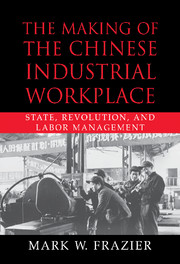Book contents
- Frontmatter
- Contents
- List of Tables
- List of Acronyms
- Preface
- 1 Introduction
- 2 Labor Management and Its Opponents, 1927–1937
- 3 Welfare and Wages in Wartime
- 4 Takeover Policies and Labor Politics, 1949–1952
- 5 Adjusting to the Command Economy
- 6 Enterprise Perspectives on the Command Economy
- 7 The Rise of “Party Committee Factories”
- 8 Conclusion
- Archives Consulted
- Bibliography
- Index
5 - Adjusting to the Command Economy
Published online by Cambridge University Press: 15 December 2009
- Frontmatter
- Contents
- List of Tables
- List of Acronyms
- Preface
- 1 Introduction
- 2 Labor Management and Its Opponents, 1927–1937
- 3 Welfare and Wages in Wartime
- 4 Takeover Policies and Labor Politics, 1949–1952
- 5 Adjusting to the Command Economy
- 6 Enterprise Perspectives on the Command Economy
- 7 The Rise of “Party Committee Factories”
- 8 Conclusion
- Archives Consulted
- Bibliography
- Index
Summary
One of the central tenets of China's industrialization strategy during the 1950s (and beyond) was the rapid accumulation of investment capital through state-owned enterprises (SOEs). SOEs were guaranteed low state-set prices on raw materials and other inputs, while profits were assured through higher prices on manufactured goods. Almost all SOE profits were turned over to the state in the form of taxes, which could then be used for additional investment capital. The adoption of this capital accumulation development strategy, with its emphasis on heavy industry, arose both from socialist ideology and the CCP's assessment of the hostile international environment in the 1950s. It is worth summarizing the key elements of the centrally planned economy of the 1950s and how in particular these constraints played out within the microeconomy of the state enterprise and its labor management policies.
During the First Five-Year Plan, employment in industrial enterprises (both state and nonstate) rose from 5.1 million in late 1952 to 7.47 million by late 1957, an average annual increase of 9.3 percent. Consistent with China's emphasis on heavy industry, workers in this sector numbered 4.5 million by year-end 1957 while light industry accounted for 2.97 million employees. In 1952, the distribution of employment between light and heavy industry had been much more evenly balanced, with 2.3 million workers in light industry and 2.8 million in heavy industry.
- Type
- Chapter
- Information
- The Making of the Chinese Industrial WorkplaceState, Revolution, and Labor Management, pp. 132 - 163Publisher: Cambridge University PressPrint publication year: 2002



